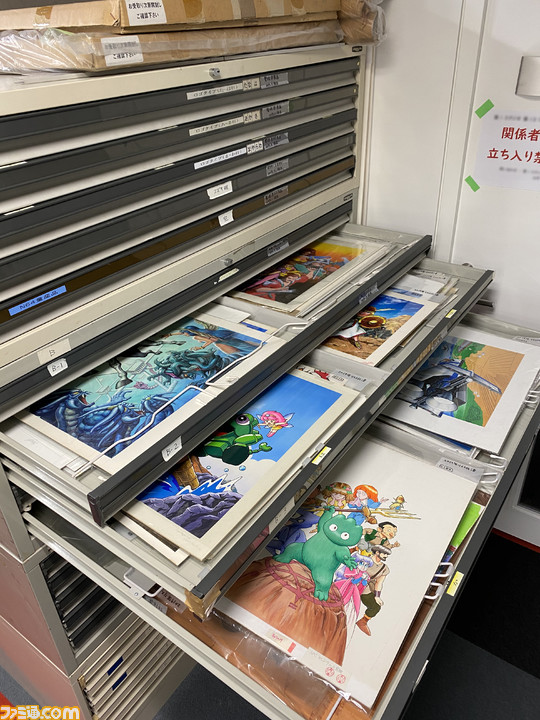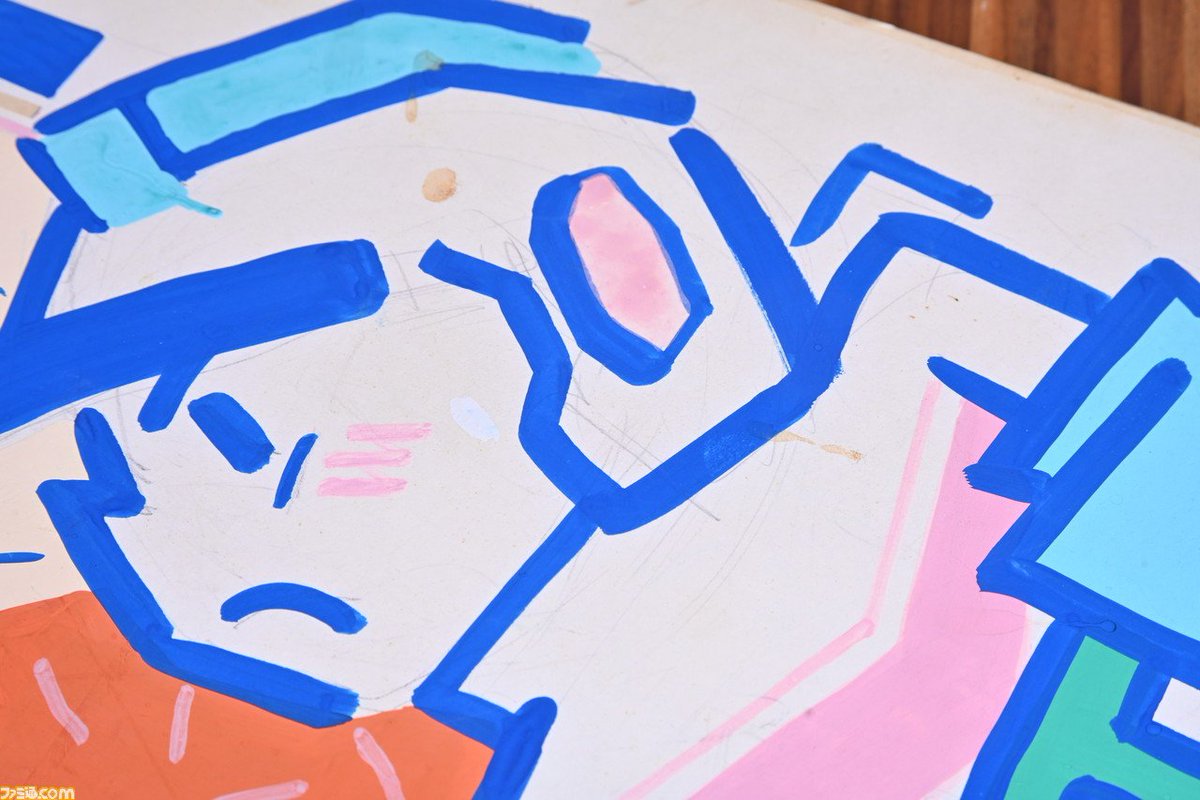
Bandai-Namco's Minoru "Oritech' Sashida & Takaharu Suzuki discuss their internal efforts to archive & preserve Namco's classic key art & the cultural importance of their work famitsu.com/news/202012/24…🇯🇵
https://twitter.com/famitsu/status/1342047442426941443
(this interview's something of a followup to the CEDEC lecture Oritech gave a few months ago on this same subject—icymi, I broke that down at the time, and I probably won't rehash anything that overlaps with this interview)
https://twitter.com/gosokkyu/status/1301145402868072448
unlike the arcade division, which stored things in various warehouses that weren't cataloged & were occasionally completely emptied upon Namco's various relocations, the home division had a repository of home game art assets that were maintained from generation to generation(>)
when Suzuki joined Namco in '95, his department had a map case that held all their key art & a lot of art from other depts that didn't know where else to put it, and so over the generations, they took special care to look after it, and it's now the centrepiece of their archive 

before they moved buildings in 2015, Oritech put out the call for original art assets, but even so, he found several assets in the trash by ppl who didn't recognise what they were tossing
on the flipside, a lot of vets were able to submit assets they'd stored at home, not bc...
on the flipside, a lot of vets were able to submit assets they'd stored at home, not bc...
...they'd intended to keep them for themselves but simply bc they didn't know what else to do with them at the time
here's one such valuable item that was recently recovered: the hand-painted rough for Dig Dug's key art—you can still see the original sketch lines up close


here's one such valuable item that was recently recovered: the hand-painted rough for Dig Dug's key art—you can still see the original sketch lines up close



one valuable loss: prototype master models of Pac-Man's monsters, made in the late '90s; only 10 were made & they were signed by Namco founder Masaya Nakamura but, bc the monster models were prototyped in clay, someone tossed them bc they smelled bad & they don't even have photos
(Pac was later upgraded to a plastic model, so he's still around)
at this point, their archive includes 212 game logos & 429 assets broadly classified as key visuals, some of which are more ambiguous or hard to identify like original assets created for Namco's NG magazine and so on, and at a guess, over 60% of that was salvaged
a lot of the ppl who created the original key visuals have reached retirement age, but Oritech has a private facebook group with a ton of former Namco guys including Hiroshi Ono, Norio Nakagata & Koichi Tokita, so when he has questions about anything, they usually have the answer
they've talked a lot in previous interviews, and this one too, about how the only way to establish a proper internal archive for the company's assets was to present a business plan & a commercial imperative, which in turn afforded them a budget
they started in 2015, however...
they started in 2015, however...
...due to another organisational shakeup, they've lost their budget again—that said, they feel like the big archival drive has largely settled, so it's not like they were suddenly cut off with any unresolved business
even so, they have plans to continue promoting Namco's key art
even so, they have plans to continue promoting Namco's key art
(one such initiative is this youtube series featuring the history of key visuals from classic Namco games—I mostly follow maniacs so it could be selective bias but I've mostly seen ppl griping about them being poorly researched)
🇯🇵
🇯🇵
🇯🇵
🇯🇵
(actually, the article does mention one of the contentions I saw about the Galaxian video, a dispute about whether this illustration was drawn by a Namco employee or outsourced) 

they really want to do more in-person exhibits of Namco's assets but now's not the time, obviously
on the prospect of an art book, Oritech likes art books but rather that putting em out every so often for the oldheads, he'd rather reach & build a broader audience via youtube etc
on the prospect of an art book, Oritech likes art books but rather that putting em out every so often for the oldheads, he'd rather reach & build a broader audience via youtube etc
here's a non-illustrated asset from Namco's archive: a mask from the live-action film adaptation of Mirai Ninja, which was directed by Keita Amemiya & featured contributions from Katsuya Terada & Takayuki Takeya 

they also talk about the archival of digital assets: finding the data is hard but there's also the issue of managing & maintaining the database, and unlike with traditional physical assets, the knowhow required to back up, read & handle digital assets can disappear very quickly
one other issue is that digital assets of a certain era are disappointingly low-resolution: because the render times on high-resolution digital art used to be obscenely long, a lot of key art was rendered at a low res and then magnified, so it's not much to look at nowadays
Oritech established an archive of high-res scans of Namco's magazine NG, as well as a ton of old flyers from arcade & business events in Japan and overseas, some dating back to the 60s—unfortunately, most of the flyers were discarded after being scanned due to storage issues
Oritech would like to expand the archive to dev docs in the future, too
on making the archives public: the issue with NG in particular is that it's full of ads & private reader info; the initially planed to make a NG e-book, but the required editing cost was deemed too expensive
on making the archives public: the issue with NG in particular is that it's full of ads & private reader info; the initially planed to make a NG e-book, but the required editing cost was deemed too expensive
they're also working on a chronological list of every Bandai-Namco game; Namco had their own numbering system for arcade games through to the late '80s but beyond that & especially factoring in Bandai & Banpresto, no such list exists & it's not necessarily easy to make a case for
they brought along some of their fav key art; Oritech brought the Motos art (outsourced to Takumi Yokooka), which he likes for being extremely '80s & for prominently focusing on the logo, as well as Keita Amemiya's Bravoman art & the cel art for Wonder Momo 





a lot of the key art for Namco's home games was unusually composed via cel art, despite it being unnecessary & cumbersome; they postulate that, unlike now, games & anime weren't talked about in the same light, so using cel art was one way to give games that anime aesthetic
Suzuki brought this illustration of the Genpei Toumaden protag by Katsuya Terada—the term chuunibyou hadn't yet been coined but when this game was new, Suzuki was in full chuuni phase & used to draw these illustrations at home all the time, so seeing the real deal was a big rush 

they also brought along the key art cels for Libble Rabble and the flyer art for Valkyrie no Densetsu 



classic key art has nostalgic value but it's also historically & functionally instructive—f.ex, Bosconian's key art: it clearly communicates the thrust of the game, it shows an element of the game in way more detail than the game itself can display & it's simply looks really cool 

a tidbit about the Bosconian key art: it was produced by the prestigious artist Shusei Nagaoka & Namco founder Nakamura liked it so much it hung in his private office, but when they moved to their current office it ended up being hung in the cafeteria; it's presumably worth a ton
...and that's pretty much it, I kinda glossed/skipped over a lot because they've covered a lot of the same ground before and also it's xmas morning and I still haven't wrapped anything, I might come back to this in a few days but don't hold me to anything
• • •
Missing some Tweet in this thread? You can try to
force a refresh






